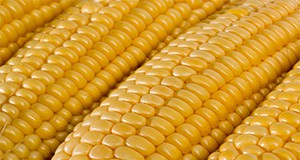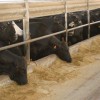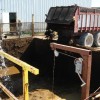 Because sandy soils have low water and nutrient-holding capacities and Florida experiences high rainfall periodically, optimizing fertilizer use efficiency for sweet corn production is challenging. The preparation of nitrogen budgets and the implementation of effective management strategies can help farmers overcome these obstacles. This 4-page fact sheet discusses major concerns which call for nitrogen management in sweet corn production, nitrogen budget preparation and interpretation, and important differences between farm-gate and soil system budgets. Written by Rishi Prasad and George Hochmuth, and published by the UF Department of Soil and Water Science, May 2015.
Because sandy soils have low water and nutrient-holding capacities and Florida experiences high rainfall periodically, optimizing fertilizer use efficiency for sweet corn production is challenging. The preparation of nitrogen budgets and the implementation of effective management strategies can help farmers overcome these obstacles. This 4-page fact sheet discusses major concerns which call for nitrogen management in sweet corn production, nitrogen budget preparation and interpretation, and important differences between farm-gate and soil system budgets. Written by Rishi Prasad and George Hochmuth, and published by the UF Department of Soil and Water Science, May 2015.
http://edis.ifas.ufl.edu/ss643
Tag: Rishi Prasad
Understanding Nitrogen Availability from Applications of Anaerobically Digested Beef-Cattle Manure in Florida Sandy Soil
 Anaerobic digestion of livestock manure is a microbe-mediated process carried out in vessels or tanks, where the livestock wastes are digested slowly in environment absent of oxygen. The main products are biogas, anaerobically digested liquid (ADL), and solid (ADS), which can be land-applied as an organic soil amendment or a source of plant nutrients. This 4-page fact sheet provides research-based information about using anaerobically digested beef-cattle manure as an organic source of nitrogen for supplementing crop nutrition in Florida sandy soils, including initial N concentration, application timing, rate of application, and method of application. Written by Rishi Prasad and George Hochmuth, and published by the UF Department of Soil and Water Science, April 2015. (Photo: George Hochmuth, UF/IFAS)
Anaerobic digestion of livestock manure is a microbe-mediated process carried out in vessels or tanks, where the livestock wastes are digested slowly in environment absent of oxygen. The main products are biogas, anaerobically digested liquid (ADL), and solid (ADS), which can be land-applied as an organic soil amendment or a source of plant nutrients. This 4-page fact sheet provides research-based information about using anaerobically digested beef-cattle manure as an organic source of nitrogen for supplementing crop nutrition in Florida sandy soils, including initial N concentration, application timing, rate of application, and method of application. Written by Rishi Prasad and George Hochmuth, and published by the UF Department of Soil and Water Science, April 2015. (Photo: George Hochmuth, UF/IFAS)
http://edis.ifas.ufl.edu/ss637
Anaerobic Digesters for Manure Management for Livestock Operations
 Livestock wastes can be important sources of nutrients for crops, but manure must be managed properly to prevent loss of nutrients to the environment in air or ground and/or surface water. Stabilization of manure is important prior to successfully recycling the organic material back to arable lands. Methods for stabilizing livestock wastes include composting, aerobic digestion, anaerobic digestion, lime stabilization, and heat drying. The stabilization process reduces the organic matter and water contents, unpleasant odors, concentrations of pathogenic microorganisms, and weed seeds. Anaerobic digestion (AD), which is the topic of this fact sheet, also results in the production of renewable energy in the form of methane-rich biogas. This 10-page fact sheet informs farmers and Extension agents about types of anaerobic digester systems used in the United States with various manure-handling systems. It points out digester systems currently being used in Florida and the benefits of managing livestock manure with a digester system. Written by Rishi Prasad, George Hochmuth, and Ann C. Wilkie, and published by the UF Department of Soil and Water Science, March 2014.
Livestock wastes can be important sources of nutrients for crops, but manure must be managed properly to prevent loss of nutrients to the environment in air or ground and/or surface water. Stabilization of manure is important prior to successfully recycling the organic material back to arable lands. Methods for stabilizing livestock wastes include composting, aerobic digestion, anaerobic digestion, lime stabilization, and heat drying. The stabilization process reduces the organic matter and water contents, unpleasant odors, concentrations of pathogenic microorganisms, and weed seeds. Anaerobic digestion (AD), which is the topic of this fact sheet, also results in the production of renewable energy in the form of methane-rich biogas. This 10-page fact sheet informs farmers and Extension agents about types of anaerobic digester systems used in the United States with various manure-handling systems. It points out digester systems currently being used in Florida and the benefits of managing livestock manure with a digester system. Written by Rishi Prasad, George Hochmuth, and Ann C. Wilkie, and published by the UF Department of Soil and Water Science, March 2014.
http://edis.ifas.ufl.edu/ss615
How to Calculate a Partial Nitrogen Mass Budget for Potato
 This 6-page fact sheet provides information on the importance of nitrogen budgets for potato cultivation and discusses the steps in preparing the budget. It allows growers to understand the inputs, cycling, and exports of nutrients within and away from the farm, develop a nutrient budget, and analyze best management practices (BMPs) for their farm. The results will be increased N fertilizer use efficiency, increased environmental protection, and reduced economic losses associated with potato cultivation. This document will also aid county agents, environmental management advisors, and government agency staff members who help farmers improve and implement nutrient BMPs to protect water quality. Written by Rishi Prasad and George Hochmuth, and published by the UF Department of Soil and Water Science, December 2013.
This 6-page fact sheet provides information on the importance of nitrogen budgets for potato cultivation and discusses the steps in preparing the budget. It allows growers to understand the inputs, cycling, and exports of nutrients within and away from the farm, develop a nutrient budget, and analyze best management practices (BMPs) for their farm. The results will be increased N fertilizer use efficiency, increased environmental protection, and reduced economic losses associated with potato cultivation. This document will also aid county agents, environmental management advisors, and government agency staff members who help farmers improve and implement nutrient BMPs to protect water quality. Written by Rishi Prasad and George Hochmuth, and published by the UF Department of Soil and Water Science, December 2013.
http://edis.ifas.ufl.edu/ss614